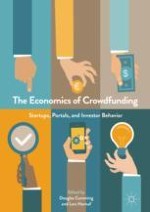2018 | OriginalPaper | Buchkapitel
4. The Crowd–Entrepreneur Relationship in Start-Up Financing
verfasst von : Thomas Lambert, Aleksandrina Ralcheva, Peter Roosenboom
Erschienen in: The Economics of Crowdfunding
Aktivieren Sie unsere intelligente Suche, um passende Fachinhalte oder Patente zu finden.
Wählen Sie Textabschnitte aus um mit Künstlicher Intelligenz passenden Patente zu finden. powered by
Markieren Sie Textabschnitte, um KI-gestützt weitere passende Inhalte zu finden. powered by
